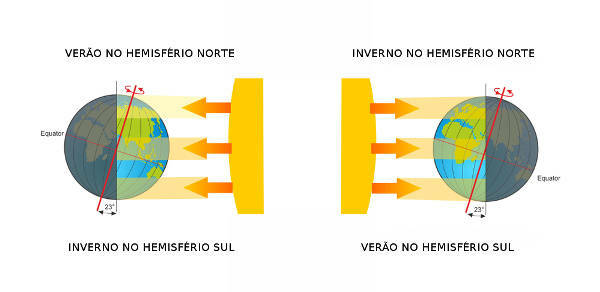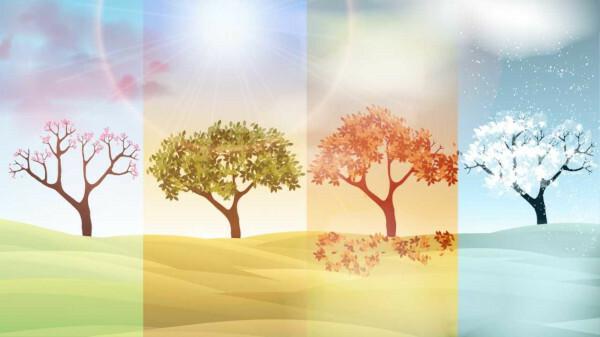At seasons represent four climatic subdivisions in a one-year period: summer, autumn, winter and spring. Seasons do not occur simultaneously all over the world, as they are determined, in each location, by the dynamics of rotation and translation of the planet.
Read too:Earth's movements
Characteristics of the seasons
The seasons of the year have particular and defined characteristics. They differ in each hemisphere due to the tilt of the Earth's axis and its rotational and translational movements. See below the main characteristics of the seasons of the year in the Northern and Southern Hemispheres.
Do not stop now... There's more after the advertising ;)
→ Seasons in the Northern Hemisphere
Summer: represents the season of the year that follows spring and precedes autumn. It is characterized by high temperatures and days longer than nights. This station usually has high rainfall. In the Northern Hemisphere, it usually starts around the 21st of June and ends around the 23rd of September. Summer in the Northern Hemisphere is called northern summer.
Autumn: represents the season of the year that follows summer and precedes winter. It is the period of the year when temperatures start to drop, except in regions located close to the equator. In this season, the leaves of the trees have a yellowish hue and fall, indicating the change from one season to another. Autumn is therefore considered a transition period. In the Northern Hemisphere, it usually starts on the 23rd of September and ends around the 21st of December. It's called northern autumn.
Winter: represents the season of the year that follows autumn and precedes spring. It is characterized by having the lowest temperatures of the year. At this time, it is common for animal species to migrate to regions where temperatures are higher. In several locations, there are frosts and blizzards during this season. It is also characterized by longer nights than days due to the lower incidence of sunlight in the region where it is in effect. In the Northern Hemisphere, it is known as boreal winter. It starts around December 21st and ends around March 20th.
Spring: represents the season of the year that follows winter and precedes summer. It is characterized by milder and more pleasant temperatures, as rainfall levels begin to increase. In this season, the days begin to lengthen, and the night to shorten. It is also characterized by the reflowering of terrestrial flora. In the Northern Hemisphere, it is known as the northern spring. It starts around March 20th and ends around June 21st.
Mind Map: Seasons of the Year

*To download the mind map in PDF, Click here!
→ Seasons in the Southern Hemisphere
Summer: it is characterized by having higher temperatures and high rainfall. At this time of year, days are usually longer than nights. In the Southern Hemisphere, it is known as the austral summer. It starts around December 21st and ends around March 20th.
Autumn: it is characterized by a gradual drop in temperatures, except in regions close to the equator. One of the main characteristics of this season is the fall of the leaves of the trees, which present yellowish tones. This season represents change, a transition period between two seasons with very different characteristics. In the Southern Hemisphere, it is known as austral autumn. It starts around March 20th and ends around June 21st.
Winter: characterized by low temperatures and, in some locations, by the occurrence of frost and snowfall. During this season, it is common to migrate several species of animals to areas with higher temperatures. Days are shorter and nights are longer, as there is less incidence of sunlight in the region in question. In the Southern Hemisphere, it is known as southern winter. It starts around the 21st of June and ends around the 21st of September.
-
Spring: characterized by having milder and more pleasant temperatures. In this season of the year, the rainfall indices gradually increase. The days get longer, while the nights get shorter. The main feature of this season is the reflowering of terrestrial flora. In the Southern Hemisphere, it is known as the southern spring. It starts around the 22nd of September and ends around the 21st of December.

The seasons of the year occur due to the Earth's translation movement, which makes the solar incidence different in the hemispheres.
Why are there seasons?
The seasons of the year occur because of the Earth's inclination in relation to the Sun. O rotation movement (rotating around its own axis) of the planet enables the existence of day and night. The Earth also performs the translation movement (I rotate around the Sun) and, due to its inclination in relation to its orbital plane, the solar incidence is different in the hemispheres. Translation is, therefore, the movement responsible for the existence of the seasons of the year, as these are defined by the position of the hemisphere in relation to the Sun. Therefore, the seasons do not occur, throughout the year, equally in both hemispheres.
Beginning of the seasons of the year in the Southern Hemisphere – 2020
Seasons |
Start |
Termination |
Autumn |
March 20, 2020 at 00:50 |
June 20, 2020 at 6:44 pm |
Winter |
June 20, 2020 at 6:44 pm |
September 22, 2020 at 10:31 am |
Spring |
September 22, 2020 at 10:31 am |
December 21, 2020 at 7:02 am |
Summer |
December 21, 2020 at 7:02 am |
March 20, 2020 at 00:50 |
Solstice and Equinox
Solstice it is an astronomical field phenomenon that represents the beginning of summer or winter in the hemispheres. It represents the period in which the Sun shines with greater intensity in one of the hemispheres due to the greater latitudinal inclination in relation to the equator. Thus, the summer solstice is characterized in one hemisphere and the winter solstice, with lower incidence of solar rays, in another.
Equinox it is an astronomical field phenomenon that represents the beginning of spring or autumn. It represents the period in which the duration of day and night is equal in both hemispheres, as they receive the same amount of light. At the equinox, sunlight falls perpendicular to the equator, causing both hemispheres to receive the same light distribution. This phenomenon only occurs twice a year.
Read more:How do the solstice and equinox occur?

Solstice and equinox are astronomical phenomena that represent the beginning of the seasons.
Seasons of the year in Brazil
In Brazil, the seasons of the year officially begin on the solstice and equinox days. They are generally well defined in states such as São Paulo, Mato Grosso do Sul, mountain regions located in Minas Gerais and Rio de Janeiro and in the southern region of the country. In the other regions, there are two well-defined seasons: a hot and humid season and a hot and dry one.
1.Summer: comprises the months of December to March and represents a vacation period (high season). It is characterized by having longer days than nights. Short-term rains can be observed throughout this season, as well as sudden changes in weather conditions. This is due to the increase in temperatures, which favors the formation of storms followed by thunderstorms.
2.Autumn: it comprises the months of March to June and represents a transition period between summer and winter. It is characterized by a reduction in rainfall. The temperature gradually drops, mainly in the South, Southeast and parts of the Midwest, due to the presence of active cold air masses. Weather conditions change quickly, and frost and fog can occur in the southern region.
3.Winter: represents a period of milder temperatures in some locations and high temperatures in others. This season comprises the months of June to September. In the Southeast and Center-West regions, this season represents the period with the lowest rainfall of the year. Cold fronts operate during this period in locations in the Southeast and South regions. Another feature is the reduction in the relative humidity of the air. It is common, at this time of year, to increase respiratory diseases due to low humidity.
4. Spring: represents an increase in rainfall. Comprises the months of September to December. In addition to the rains being more frequent, temperatures become milder. It is characterized, therefore, for being a transition period between a very dry and a very wet season. Temperatures in the Midwest, Southeast and South regions show an increase throughout this season.
Summary
Seasons are climatic subdivisions of periods throughout the year. They are: spring, summer, autumn and winter. Its occurrence is due to the fact that the Earth performs movements around its own axis (rotation) and in around the Sun (translation), causing the incidence of solar rays to be uneven in the Northern and South.
Summer represents the season of the year with generally high temperatures and high rainfall. In winter, temperatures drop significantly, and there may be snow and frost in some places on the planet. Spring represents the season with milder temperatures, representing the transition between winter and summer. Autumn is marked by changes in the landscape, with falling leaves on trees and a gradual decrease in temperatures.
by Rafaela Sousa
Graduated in Geography
The astronomical phenomenon of __________________ is characterized by the higher incidence of solar radiation in a given hemisphere. He is responsible for the summer and winter seasons.



